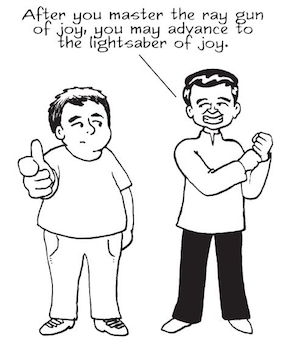How to Bring Humor to Meditation
By Kira M. Newman
A new book teaches mindfulness by emphasizing ease, joy, and jokes.
 From Joy on Demand by Chade-Meng Tan, cartoons by Colin Goh; reprinted with permission from HarperOne, an imprint of HarperCollins Publishers
From Joy on Demand by Chade-Meng Tan, cartoons by Colin Goh; reprinted with permission from HarperOne, an imprint of HarperCollins Publishers
 From Joy on Demand by Chade-Meng Tan, cartoons by Colin Goh; reprinted with permission from HarperOne, an imprint of HarperCollins Publishers
From Joy on Demand by Chade-Meng Tan, cartoons by Colin Goh; reprinted with permission from HarperOne, an imprint of HarperCollins Publishers
A new book teaches mindfulness by emphasizing ease, joy, and jokes.
From the outside, meditation appears to be a thoroughly serious endeavor. You have to sit down, dutifully count your breaths and rein in your wandering mind, and practice this every day whether it’s fun or not.
But that isn’t Chade-Meng Tan’s approach to mindfulness. The founding chair of the Search Inside Yourself Leadership Institute, which started as a mindfulness class at Google and now trains employees around the world, Tan lives by the motto that “life is too important to be taken seriously.” And he adopts the same attitude toward cultivating mindfulness—outlined in his new book, Joy on Demand: The Art of Discovering the Happiness Within.
While Tan acknowledges that there are other routes to mastering meditation (including sheer discipline and will), his focus is on joy. The book—peppered with cartoons in every chapter—teaches practices and principles for cultivating mindfulness that emphasize gentleness and ease, and lead to a life suffused with positive feeling.
“With practice, joy can become your personality and your whole life,” Tan writes. “What is neutral will become joyful, and what is joyful will become even more joyful.” He himself is living proof of this philosophy—his official title while at Google, printed on his business card, was “Jolly Good Fellow.”
 From Joy on Demand by Chade-Meng Tan, cartoons by Colin Goh; reprinted with permission from HarperOne, an imprint of HarperCollins Publishers
From Joy on Demand by Chade-Meng Tan, cartoons by Colin Goh; reprinted with permission from HarperOne, an imprint of HarperCollins Publishers
Tan encourages lightness and playfulness in the way we think about mindfulness training in the first place. In a chapter called “Happiness Is Full of Crap,” he mentions teachings that compare the mind to “a piece of pure gold inside a big ball of cattle dung.” (“Great spiritual teachers tend to be funny people,” he observes.) In other words, we all have happiness within us; we just have to clear away the nasty habits of thinking that obscure it, which is part of the goal of mind training.
One of the practices he recommends is the ten-minute “Puppy Dog Meditation,” which has five steps that correspond to training a puppy:
- Relax: “Relax and allow your puppy [mind] to wander, but if she gets too far away, gently and lovingly carry her back.”
- Rejoice: “Now, the puppy is familiar with you and loves you, and she likes to sit next to you. When she does, you rejoice. If you catch her wandering, also rejoice at having such a lovely puppy before gently bringing her back.”
- Resolve: “Now the puppy is a young dog and is ready for training. During training, you resolve to firmly enforce discipline [attention], in a gentle and loving way.”
- Refine: “Now that your young dog is properly trained, it is time to refine her skills [attend to the subtle nature of the breath].”
- Release: “Your dog is well trained and can be unleashed. . . . Let go of all effort and allow the mind to just be.”
 From Joy on Demand by Chade-Meng Tan, cartoons by Colin Goh; reprinted with permission from HarperOne, an imprint of HarperCollins Publishers
From Joy on Demand by Chade-Meng Tan, cartoons by Colin Goh; reprinted with permission from HarperOne, an imprint of HarperCollins Publishers
In another, particularly delightful practice, Tan recommends that we take a moment every hour to wish for two people at our workplace to be happy, thinking, “I wish for this person to be happy, and I wish for that person to be happy.”
“If you like, you may pretend you are firing a ‘happiness ray gun’ at them and make ‘pew, pew’ sound effects in your head. Batteries not required,” Tan adds.
This is a micro version of loving-kindness meditation, where you generate feelings of goodwill and warmth toward others by wishing them well. Loving-kindness meditation has been shown to generate more positive attitudes toward the self and others and more positive emotions, which in turn can lead to a greater sense of connection to others, improved vagal tone (a measure of cardiac health), fewer symptoms of illness, higher life satisfaction, and less depression.
Lest we think all this humor is only for the innately cheerful, Tan assures us that he isn’t a naturally happy person; in fact, he was miserable for most of his childhood. Since then, he’s sometimes battled intense feelings of worthlessness and periods of overwhelming suffering in his life. But he now believes that humor is available to us even in moments of pain, at least some of the time.
Research backs him up: There’s some evidence that humor can help us cope with traumatic situations. Laughter releases dopamine, increases blood flow, and strengthens the heart. In one study, humor was even more effective than positivity at alleviating negative feelings. The benefits of laughter are no laughing matter.
And mindfulness isn’t just for happy times, either. Research suggests that mindfulness and mindfulness-based therapies can help students coping with failure and self-doubt, help veterans battling post-traumatic stress disorder, and help those suffering from depression and anxiety.
Amidst all the cartoons and jokes, it’s easy to forget that Tan himself is extraordinarily serious about mindfulness. He’s been practicing for 21 years, and he now meditates for three hours a day. Although anyone can get a hint of joy from a calming, mindful breath or a short loving-kindness meditation, it takes dedication to build a life where joy is the default state.
Tan’s advice for those who want to follow in his footsteps? “Don’t stop and don’t strain.” Practice, but not to the point of tension and rigidity. Be dedicated and persistent, but gentle and lighthearted at the same time. That is the path to joy.